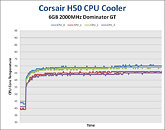- Joined
- Oct 9, 2007
- Messages
- 47,686 (7.42/day)
- Location
- Dublin, Ireland
| System Name | RBMK-1000 |
|---|---|
| Processor | AMD Ryzen 7 5700G |
| Motherboard | Gigabyte B550 AORUS Elite V2 |
| Cooling | DeepCool Gammax L240 V2 |
| Memory | 2x 16GB DDR4-3200 |
| Video Card(s) | Galax RTX 4070 Ti EX |
| Storage | Samsung 990 1TB |
| Display(s) | BenQ 1440p 60 Hz 27-inch |
| Case | Corsair Carbide 100R |
| Audio Device(s) | ASUS SupremeFX S1220A |
| Power Supply | Cooler Master MWE Gold 650W |
| Mouse | ASUS ROG Strix Impact |
| Keyboard | Gamdias Hermes E2 |
| Software | Windows 11 Pro |
Corsair Labs recently conducted testing to determine whether the use of high-performance DDR3 memory for Core i7 platforms also requires the use of more effective CPU cooling products.
The results clearly show that using high-performance memory results in increased CPU temperatures, due to the higher CPU VTT voltages and Uncore clock speeds required by the IMC (Integrated Memory Controller) in the Core i7 processor. The average load temperature of a Core i7-920 processor cooled by the Intel HSF (heatsink and fan) was 11 degrees C higher when utilizing 2000MHz C8 Dominator GT memory compared to 1333MHz DDR3 memory. The same PC cooled using the Corsair H50 CPU Cooler maintained average CPU core temperatures up to 24 degrees C lower than the stock Intel HSF, and was able to stably cool an overclocked CPU while also maintaining a 2000MHz DDR3 memory frequency.


Standard CPU cooling solutions are inadequate for effectively cooling a Core i7-based PC using memory at frequencies above 1600MHz. Using high-performance memory running at 1866MHz or above (set by the XMP profile), the stock Intel Cooler was unable to stably cool the test PC, resulting in system crashes (BSODs) or processing errors.


Enthusiasts who are looking to overclock Core i7 processors while maximising memory performance will therefore need to remove the additional heat generated due to high-performance memory and CPU overclocking by using a high-performance CPU cooling solution.
The full application note, AN901: The Impact of High-Speed DDR3 Memory on Core i7 Processor Temperatures, is available from the Corsair website here.
View at TechPowerUp Main Site
The results clearly show that using high-performance memory results in increased CPU temperatures, due to the higher CPU VTT voltages and Uncore clock speeds required by the IMC (Integrated Memory Controller) in the Core i7 processor. The average load temperature of a Core i7-920 processor cooled by the Intel HSF (heatsink and fan) was 11 degrees C higher when utilizing 2000MHz C8 Dominator GT memory compared to 1333MHz DDR3 memory. The same PC cooled using the Corsair H50 CPU Cooler maintained average CPU core temperatures up to 24 degrees C lower than the stock Intel HSF, and was able to stably cool an overclocked CPU while also maintaining a 2000MHz DDR3 memory frequency.


Standard CPU cooling solutions are inadequate for effectively cooling a Core i7-based PC using memory at frequencies above 1600MHz. Using high-performance memory running at 1866MHz or above (set by the XMP profile), the stock Intel Cooler was unable to stably cool the test PC, resulting in system crashes (BSODs) or processing errors.


Enthusiasts who are looking to overclock Core i7 processors while maximising memory performance will therefore need to remove the additional heat generated due to high-performance memory and CPU overclocking by using a high-performance CPU cooling solution.
The full application note, AN901: The Impact of High-Speed DDR3 Memory on Core i7 Processor Temperatures, is available from the Corsair website here.
View at TechPowerUp Main Site









